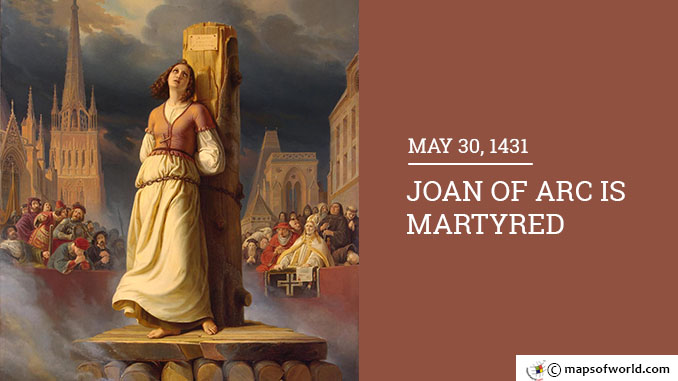Over two years after she won her historic victory against the English, Jeanne d’Arc or Joan of Arc was burnt at the stake for heresy on May 30, 1431. The Maid of Orléans, 19-year-old Joan was martyred following an inquisition headed by Bishop Pierre Cauchon. Joan of Arc was later beatified in 1909 and canonized in 1920 and is now regarded as one of the patron saints of France. The Kingdoms of England and France had been embroiled in bitter war since 1337 over the rightful claim to the throne of France (The Hundred Years’ War). The war had raged through the Edwardian Era (1337–1360) and the Caroline Era (1369–1389) by the time Joan was born on January 6, 1412 to a farmer and doyen in Domrémy. The last of five children, Joan was a devout Catholic from a very early age. As a young teenager, Joan had encountered a divine vision — she claimed that St. Michael, St. Margaret, and St. Catherine had appeared to her in a field and instructed her to reinstate Dauphin Charles VII to the throne of France and fight the English army. Joan was profoundly moved by the voices and decided to act upon their instructions. By this time, Henry VI had ascended the throne of England and had established successful dominion over Burgundy and northern France, including at Reims and Paris, while Charles VII was in exile. Joan gained an audience with Charles and convinced him to allow her to join the troops heading to Orléans. Her narration of the “voices” that influenced her made her a suspected witch. Charles was very apprehensive of sending Joan to war. A woman soldier was unheard of at the time. Joan was also a mere teenager then. Her religious allegiance was also suspect. Charles’ advisors suggested sending her to war dressed as a regular knight. They surmised that if Joan was indeed protected by the saints, she would secure a victory that was deemed well-nigh impossible. Joan fired up the French troops. Having secured a string of victories against the English, the young peasant girl had started to roll back the English and became a major concern for Henry VI. With Joan’s victories, all of France rose up against English dominion. Joan formed a bold plan to seize Reims and crown the Dauphin. Through 1429, she moved French troops from Orléans and Reims fell to the impassioned French army in July. Charles was crowned the legitimate king, but Philip of Burgundy held on to Paris. Joan again went up against the English army in Compiègne, in May 1430, but was captured by Philip of Burgundy. Charles refused an offer to ransom Joan and Philip handed her over to the English. Bishop Pierre Cauchon took charge of Joan’s inquisition at Rouen in January 1431. Despite a lack of evidence, Joan was imprisoned for seven months, tried for six days, forced to sign a confession. Condemned of heresy and insubordination and deemed a witch, Joan was burnt at the stake on May 30, 1431, at the center of the city. A quarter of a century later, Pope Callixtus III nullified the charges leading up to her eventual beatification. Also On This Day: 1842 – John Francis attempts to assassinate Queen Victoria. 1913 – The First Balkan War ends. 1922 – The Lincoln Memorial is dedicated in Washington D.C. 1942 – British planes bombard Cologne in Operation Millennium. 1981 – The president of Bangladesh, Zia ur Rahman, is assassinated.
May 30 1431 – Joan of Arc is Martyred
Over two years after she won her historic victory against the English, Jeanne d’Arc or Joan of Arc was burnt at the stake for heresy on May 30, 1431. The…
491
